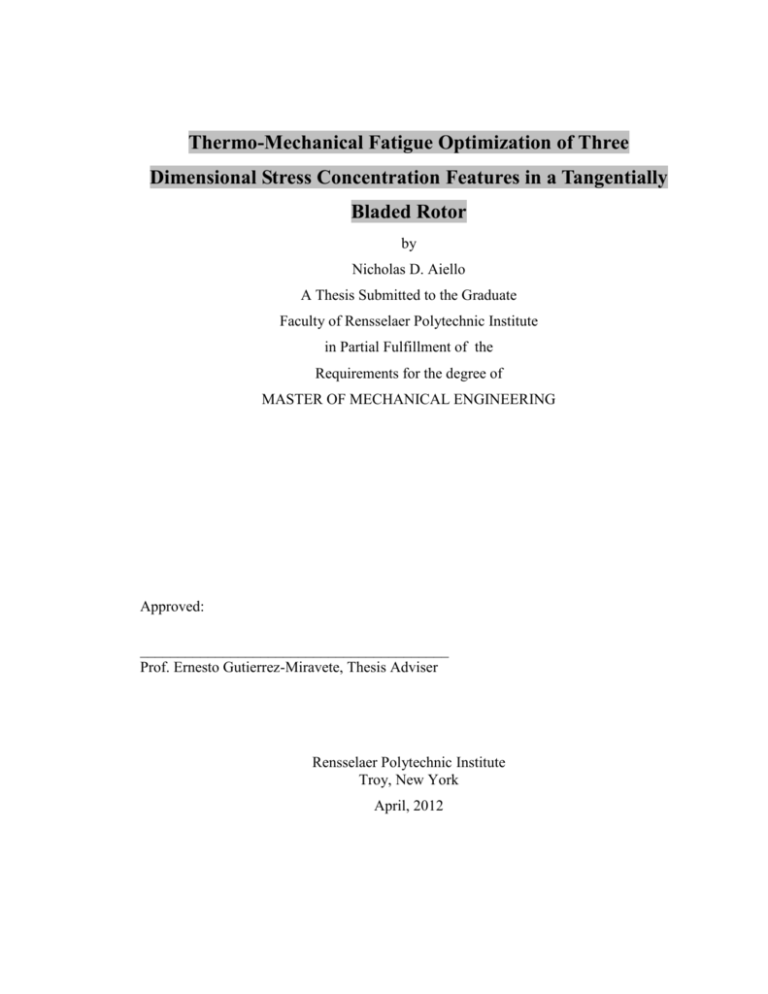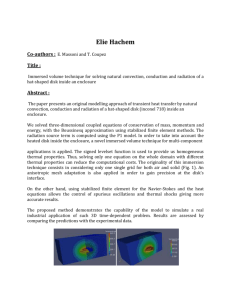
Thermo-Mechanical Fatigue Optimization of Three
Dimensional Stress Concentration Features in a Tangentially
Bladed Rotor
by
Nicholas D. Aiello
A Thesis Submitted to the Graduate
Faculty of Rensselaer Polytechnic Institute
in Partial Fulfillment of the
Requirements for the degree of
MASTER OF MECHANICAL ENGINEERING
Approved:
_________________________________________
Prof. Ernesto Gutierrez-Miravete, Thesis Adviser
Rensselaer Polytechnic Institute
Troy, New York
April, 2012
© Copyright 2012
by
Nicholas D. Aiello
All Rights Reserved
ii
CONTENTS
LIST OF TABLES .......................................................................................................... ivv
LIST OF FIGURES ........................................................................................................... v
LIST OF SYMBOLS ........................................................................................................ vi
ACKNOWLEDGMENT ................................................................................................. vii
ABSTRACT ................................................................................................................... viii
iii
LIST OF TABLES
iv
LIST OF FIGURES
Figure 1: Load, Lock, and Shield Slot Configuration ....................................................... 3
Figure 2: NX CAD Model of 3D Sector ............................................................................ 4
Figure 3: Meshed 3D Sector Model................................................................................... 5
Figure 4: Element Types in 3D Model .............................................................................. 5
Figure 5: Node Files for Boundary Condition Mapping ................................................... 6
Figure 6: 3D Detail of Blade-Disk Interface Area............................................................. 8
v
LIST OF SYMBOLS
R = radial coordinate of cylindrical system, goes from rotor centerline outward in
3D finite element model
θ = circumferential coordinate of cylindrical system, follows “right hand rule” with
Z axis in 3D finite element model
Z = axial coordinate of cylindrical system, goes from forward to aft of rotor in 3D
finite element model
vi
ACKNOWLEDGMENT
Type the text of your acknowledgment here.
vii
ABSTRACT
Thermo-mechanical fatigue has become a significant concern with respect to rotor life in
turbine engines as maximum metal temperatures have increased in newer designs. Stress
concentration features, such as those present in a tangentially bladed rotor, tend to be the
primary areas of concern for this type of fatigue. This paper will explore the
optimization of a set of three dimensional stress concentration features, using both two
and three dimensional finite element analysis, subject to the realistic design constraints
of
a
functional
tangentially
bladed
viii
rotor
in
a
turbine
engine.
1. Introduction
Thermo-mechanical fatigue (TMF) is a mechanism that causes damage to parts
subjected to transient thermal loading in their within the operational envelope. This
failure mechanism is of concern in several industries including both automotive and
aerospace (3). In the aerospace industry, parts subjected to this type of fatigue include
blades/airfoils and disks/rotors (henceforth used interchangeably) in the high
temperature sections of gas turbine engines. This becomes even more of a concern as
new products push temperatures even higher to help meet industry demands for higher
efficiency propulsion systems.
Focusing on gas turbine engine rotors, the means by which thermo-mechanical
fatigue is introduced deals mainly with the mission profile of the engine. In commercial
aircraft engines, for example, a typical mission includes take-off, climb, cruise, descent,
and landing. The points of the mission in which thermal large thermal transients exist are
at the beginning of the mission (take-off/climb) and the end of the mission
(descent/landing). These are the primary points of interest in the analysis of rotor parts
for thermo-mechanical fatigue.
During the take-off portion of a commercial turbine engine mission, the gas path
of the engine heats up, while the portions of the engine inside the gas path annulus
remain cool. Since a typical rotor consists of a radially outboard and fairly thin rim
directly exposed to the gas path, a massive bore at the most radially inboard point, and
thin web connecting them, this sudden heating up of the gas path heats the rim of the
disk rapidly, but the disk’s massive bore takes much longer to heat up. This causes a
thermal fight in the disk as the rim wants to thermally expand, while the bore holds it
back. What results is a compressive hoop stress field in the rim of the disk that increases
to a maximum during the portion of take-off with largest transient thermals, and then
dissipates as the bore of the disk begins to respond to the increase in flow path
temperatures.
During the descent portion of this typical mission, the opposite of this
phenomenon is in effect. Going from a cruise condition, where the entire engine is
essentially at a thermal equilibrium, to descent, the engine’s gas path suddenly takes on
cooler air. This cools the rim of the disk rapidly, while the bore remains hot. This time
1
the thermal fight in the rotor occurs in the opposite direction. The disk rim wants to
contract due to the decrease in gas path temperature, while the hot bore will not let it.
This results in a tensile hoop stress field at the rim of the disk that behaves in the
opposite manner as compared to the takeoff cycle, meaning the thermally induced hoop
stresses decrease as the bore cools after reaching a maximum transient point during the
descent.
The thermo-mechanical stresses introduced on the rim of a rotor throughout a
mission become particularly problematic when the rotor has some sort of stress
concentrating feature, such as a slot, in the rim of the disk. In the case of a tangentially
bladed rotor, stress concentrating feature generally consist of locking and loading slots.
Loading slots serve as a means of installing blades into a tangential disk. Locking slots
accept locks that are loaded intermittently between blades. These locks serve as a means
of transmitting load between the blades and disk at low power (until friction takes over)
such that the blades don’t freewheel in the disk as well as a means of ensuring the blades
cannot escape through the loading slot. The shape and orientation of these stress
concentrating features to one another is dictated by several design considerations, but
also can have an impact on how large of a stress concentration (or Kt) each feature
actually imposes upon the disk rim. This paper will focus on optimizing the shape and
location of these stress concentrating features, subject to constraints of design
considerations, in order to maximize TMF life for the rotor part.
2
2. Methodology
The objective of this thesis project is to create a method of optimizing three
dimensional features, in this particular case a load, lock, and shielding slot configuration
(See Figure 1), for a tangentially bladed rotor such as that of a turbine engine. The
optimization routine explores the design space of the problem, given a set of inputs, and
chooses an optimal solution based on output parameters/targets. Inputs to the
optimization routine account for the shape of the whole rotor, the thermal profile for the
rotor, the mission that the part is subjected to, a parameterized shape of each slot, and the
shape of the blade root that must fit in the loading slot; and output parameters are
stresses in each feature and in corresponding far-field locations of the rotor at several
mission points, the corresponding temperatures at which these stresses occur, and a
calculated TMF life using these outputs. The optimal solution maximizes TMF life in
these features within pre-set boundaries by balancing their lives with one another while
still allowing for installation of a tangential blade into the rotor.
Figure 1: Load, Lock, and Shield Slot Configuration
3
The first step in this project is to evaluate a baseline design for the rotor. The
analysis is conducted on a three dimensional (3D) sector model of a bladed disk and is
run for a complete mission (using ANSYS as a finite element solver). More specifically,
the model is of the area surrounding the tangential groove of disk, from the upper web to
the disk rim (see Figure 2). This was made by first creating a CAD (computer aided
design, NX Unigraphics used) model of the geometry to be analyzed in 3D, then creating
a finite element mesh representation of that model (meshed using ANSYS, see Figure 3).
The mesh consists primarily of 3 types of elements: 10 node tetrahedron elements for the
complex geometry of the area surrounding the 3D slot features, 8 node brick elements
for the axi-symmetric portions of the disk to help keep the element count down and
increase run speed, and 20 node brick elements that collapse to form the pyramid shaped
elements that connect the other 2 element types (see Figure 4). The blades in the model
are represented as a finite element mesh of the portion of the blade root below the neck
(also called the blade stump) with a mass point at the center-of-gravity of the upper
portion of the blade connected to the blade stump by high stiffness spring elements.
Figure 2: NX CAD Model of 3D Sector
4
Figure 3: Meshed 3D Sector Model
Figure 4: Element Types in 3D Model
5
The effect of the rest of the disk is simulated by mapping deflections from a
previously created two dimensional (2D) model onto the corresponding cut boundaries
of the 3D model for each mission point analyzed with that model. This was done by first
exporting the nodes of the 3D finite element model into a separate file. These nodes,
representing the shape of the 3D model, were then all rotated to the mid-plane of the
model (i.e. θ=0), after ensuring their nodal coordinate systems were set to the cylindrical
system being used in the rest of the model. The completed model, containing all of the
nodes of the 3D model compressed into a 2D format (see Figure 5), was saved as another
separate file for use in mapping the thermal response of the rotor. Continuing work on
the node file for mapping of deflection boundary conditions, compressed nodes now in
2D that are not located on the model’s cut boundaries were deleted, leaving only the
nodes residing directly on the boundaries (see Figure 5). The deflections from the 2D
model were then mapped onto these nodes for each mission point that the 3D model will
analyze, ensuring that compensation was made for any differences in coordinate
assignments, and degree-of-freedom boundary conditions files were created for each
point. Similarly, the node file containing all of the 3D model nodes compressed into a
2D format is used to map temperatures on each node for each 3D mission point and
creating thermal boundary condition files for each point. These boundary condition files
are later loaded into the 3D finite element model when the analysis is run.
Figure 5: Node Files for Boundary Condition Mapping
6
Before the model can be run, though, there are a few more boundaries in the 3D
finite element model that need to be resolve, those being the free sides of the disk sector
and the interface of the blade stumps to the disk. The free sides of the disk sector were
given the boundary condition of not allowing movement in the circumferential (θ)
direction. This still allows the disk model to move radially and axially at the boundaries,
but the lack of circumferential motion simulates the existence of the rest of the axisymmetric portion of the rotor. Doing this does not allow for any three dimensional
effects to transfer through the end of the 3D rotor section, so it is important that model
sector is chosen such that the behavior near the sector edges is indicative of the axisymmetric behavior of the rotor. That resolved, the last issue is the interface of blade
stumps to the disk’s bearing surface in the tangential groove (see Figure 6). This
interface was resolved using contact elements between the corresponding sets of faces.
The contact elements used were set to frictionless contact with no separation of face,
which allows the blade to slide along the disk’s bearing surface but not separate from it.
This contact behavior was chosen as an approximation of the actual blade/disk interface
behavior because it helps simplify the model in a way that increases run speed and
decreases likelihood of non-convergence of the finite element solution. The final step in
completing boundary resolution of the 3D model was to constrain the airfoils so that
they, too, could not move in the circumferential direction. This resolves the
circumferential movement still possible with no-separation contacts, and is a fairly
accurate approximation of blade behavior in a tangential disk as the friction force on the
blade bearing surface due to radial blade pull generally keeps a blade in place
circumferentially at most engine operational speeds.
7
Figure 6: 3D Detail of Blade-Disk Interface Area
With the boundary conditions of the 3D model now resolved, the model is ready
to run. A run file was created that loads the various inputs (finite element model with
internal boundary conditions, deflection cut boundary conditions, and thermal
conditions), and applies the correct set of inputs and rotational speeds for each mission
point in the set.
8
3. References
1. Determination of stress concentration factors of a steam turbine rotor using FEA
Nagendra Babu, R.; Ramana, K.V.; Rao, K. Mallikarjuna Source: Proceedings of the 2nd
WSEAS International Conference on Engineering Mechanics, Structures and Engineering
Geology, EMESEG '09, p 56-59, 2009, Proceedings of the 2nd WSEAS International
Conference on Engineering Mechanics, Structures and Engineering Geology, EMESEG
'09
2. Overview of High Temperature and Thermo-mechanical Fatigue (TMF)
Sehitoglu, H. Source: University of Illinois Mechanical and Industrial Engineering
3. Simulation of complex thermomechanical fatigue
Bardenheier, R.; Rogers, G. Source: Acta Metallurgica Sinica (English Letters), v 17, n 4,
p 400-406, August 2004
4. Thermo-Mechanical Fatigue Life Prediction: A critical Review
Zhuang, W.Z.; Swansson, N.S. Source: DSTO Aeronautical and Maritime Research
Laboratory, January 1998
5. Turbine blade fir-tree root design optimisation using intelligent CAD and finite
element analysis
Song, Wenbin; Keane, Andy; Rees, Janet; Bhaskar, Atul; Bagnall, Steven Source:
Computers and Structures, v 80, n 24, p 1853-1867, September 2002
9










